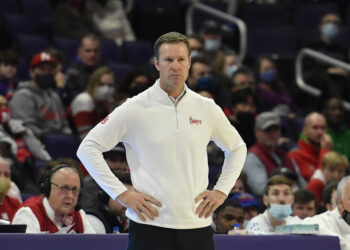Oregon Football will be among the latest round of realignment when it enters the Big Ten Conference this fall.
The phenomenon has been part of college athletics since for longer than any of us have been alive, but it really took off when the Big Ten added Nebraska more than a decade ago. That same cycle had Colorado off to the Pac-12 and Missouri to the SEC. The Big Ten would later add Maryland and Rutgers, and is now welcoming UO, UCLA, USC, and Washington.
Only the Big Ten additions made bowl games in their first seasons out of that group, and only Nebraska posted consecutive years with nine wins. As matter of fact, the Huskers looked to be achieving a level of sustained success over their first few years in the league.
As Oregon becomes one of the newcomers, how is it set up compared to previous additions? In a word: better. In two words: much better.
Oregon quarterback Luke Moga and offensive lineman Josh Connerly Jr. celebrate after a touchdown during the Oregon Ducks’ Spring Game Saturday, April 27. 2024 at Autzen Stadium in Eugene, Ore. / Ben Lonergan/The Register-Guard / USA
Rutgers and Maryland both joined the league in 2014. Since then, they have combined to make eight bowl appearances out of 20 opportunities, with five of those coming in the last three years. Both could have better days ahead with the Big Ten going away from divisions and them being locked into annual games against all of Ohio State, Michigan, and Penn State.
Nebraska posted six consecutive bowl seasons upon entering the Big Ten. The first four, all under Bo Pelini, had NU at the nine-win mark. In 2012, the Huskers made the Big Ten Championship out of the Legends Division.
But then the Huskers fired Pelini, and successor Mike Riley lasted jus three years, with his final season beginning a streak of seven straight years without a bowl appearance.
Nov 22, 2014; Lincoln, NE, USA; Nebraska Cornhuskers head coach Bo Pelini walks the sideline against Minnesota Golden Gophers in the first half at Memorial Stadium. / Bruce Thorson-USA TODAY Sports
But where did it go wrong for Nebraska foundationally and how can Oregon avoid the same issues? Answer: Recruiting.
Nebraska’s recruiting classes from 2007 (the final year Bill Callahan would coach) to 2014 (the final year under Pelini) had Rivals rankings of 13, 30, 28, 22, 15, 25, 17, and 32. The Huskers had a trio of top-20 classes under Scott Frost, but retention was a major issue, as was winning games or not electing to onside kick the ball up 11 points in the second half in Dublin.
Beginning with the 2020 class, Oregon has had final rankings of 9, 3, 23, 9, and 6. As of publishing, the 2025 class is currently No. 4.
Oregon offensive coordinator Will Stein talks with quarterback Dillon Gabriel during practice with the Oregon Ducks Saturday, April 6, 2024 at the Hatfield-Dowlin Complex in Eugene, Ore. / Ben Lonergan/The Register-Guard / USA
The Ducks have a pattern of talent acquisition that exceeds anything done by the Big Ten additions since 2012. Much of that impact comes from Dan Lanning at the helm and the backing of Phil Knight and the aura of Nike. Add in three consecutive 10-win seasons, something Penn State didn’t even have upon entering in 1993, and you have recipe for Oregon to have immediate and sustained success in the Big Ten Conference.
Stay up to date on all things Oregon Ducks by visiting Oregon Ducks on SI daily and following Oregon Ducks on SI on Facebook and X.
Source link : https://www.si.com/college/oregon/football/why-oregon-football-is-better-equipped-for-big-ten-transition-than-previous-additions-nebraska-huskers-dan-lanning
Author :
Publish date : 2024-07-05 16:01:19
Copyright for syndicated content belongs to the linked Source.





